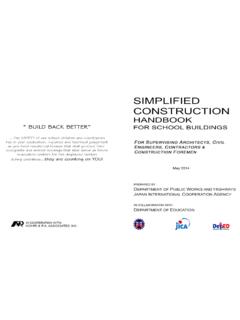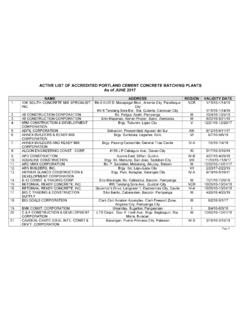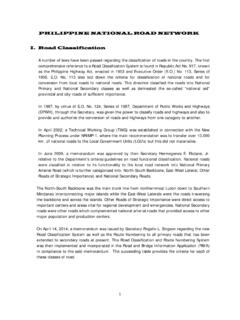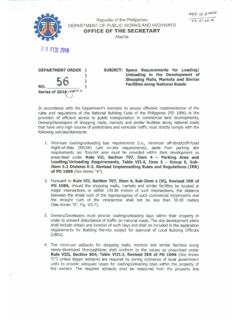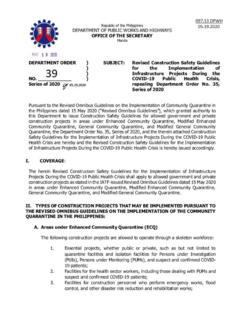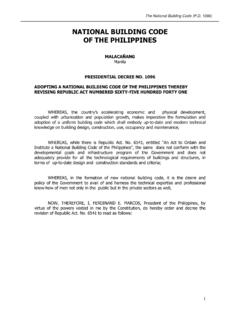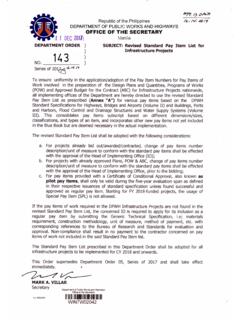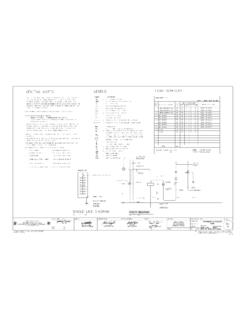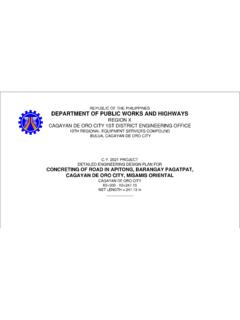Transcription of DEPARTMENT ORDER SUBJECT: PRESCRIBING GUIDELINES …
1 Republicof thePhilippinesDEPARTMENTOFPUBLICWORKSAND HIGHWAYSOFFICEOFTHESECRETARYM anilaQq'l.\?JDP~\\()C1'?Jv.' > 2t> sr' >/~OIn linewiththecontinuingeffortsof theDPWHto supportthepromotionof activemodesoftransportbythegovernment,th eattachedANNEX"A",GuidelinesontheDesigno fBicycleFacilitiesAlongNationalRoads,pro vidinga uniformdesignof bicyclefacilitiesin ordertoachievea consistentapproachthatwillmeettheneedsan dsafeaccessofbicyclistsandotherroadusers ,is herebyprescribedfortheguidanceandcomplia nceof 9 2020 DEPARTMENTORDER)))) futureexpansiontorelievetrafficcongestio nssuchasroad/bridgewidening,diversion/by passroads,amongothers,shallincludein itsdesigntheprovisionofbicyclefacility,i f feasible,basedonthe,. theBureauofDesignandapprovalof ,theformheretoattachedasAnnex"B"is PublicWorksandHighwaysOfficeof ,Seriesof 2020 PrescribingGuidelineson theDesignof BicycleFacilitiesAlongNationalRoadsAnnex "A"DEPARTMENTOFTRANSPORTATIONDEPARTMENTO FPUBLICWORKSANDHIGHWAYSGUIDELINESON THE DESIGNOF BICYCLEFACILITIESALONGNATIONALROADS DEPARTMENT OF TRANSPORTATION DEPARTMENT OF PUBLIC WORKS AND HIGHWAYS GUIDELINES ON THE DESIGN OF BICYCLE FACILITIES ALONG NATIONAL ROADS Contents A.
2 DEFINITION OF TERMS .. 1 B. BICYCLE FACILITY CLASSIFICATIONS .. 2 2. Class II: Separated Bike Lane using pavement Markings or Physical Separation .. 2 3. Class III: Shared Roadway .. 2 C. GENERAL GUIDELINES FOR THE PROVISION OF BICYCLE FACILITIES ON EXISTING ROADS AND BRIDGES .. 2 1. Bicycle Facility Selection .. 2 2. Bicycle Operating Space for Road .. 3 Establishing Width Criteria .. 3 Establishing Directional Criteria .. 3 Separated Bike Lane using pavement Markings or Physical Separator .. 4 Cross-slope and Longitudinal Grade .. 4 Vertical Clearance .. 4 3. Bicycle Operating Space for Bridge/Viaduct .. 4 Bridge/Viaduct .. 4 Railings .. 5 4. Conflict Areas .. 5 Intersection .. 5 Driveway and Commercial Properties .. 6 Transit Stops .. 6 5. Grade Separated Crossings .. 6 Pedestrian and Bicycle Bridge .. 6 Pedestrian and Bicycle Tunnel/Underpass .. 7 6. Batas Pambansa BLG. 344 (Accessibility Law) .. 8 7. Road Signs and pavement Markings.
3 8 8. Bikeway Facility Maintenance .. 9 9. Bicycle Parking Facilities/Amenities .. 9 Classification of Bicycle Parking Facilities .. 9 Criteria For Good Quality Bicycle Parking .. 10 Building Facility .. 11 Standard Bicycle Parking Dimensions .. 11 10. Existing Utilities .. 12 11. Lane Width Reduction for Road and Bridge .. 12 D. GENERAL GUIDELINES FOR THE PROVISION OF BICYCLE FACILITIES ON NEW CONSTRUCTION OF ROADS AND BRIDGES .. 12 E. APPLICABILITY OF GUIDELINES OTHER THAN NATIONAL ROAD .. 13 F. OTHER CONSIDERATIONS IN THE PROVISION OF BICYCLE FACILITIES ALONG NATIONAL ROADS .. 14 DEPARTMENT OF TRANSPORTATION DEPARTMENT OF PUBLIC WORKS AND HIGHWAYS GUIDELINES ON THE DESIGN OF BICYCLE FACILITIES ALONG NATIONAL ROADS A. DEFINITION OF TERMS In line with the purpose of this DEPARTMENT ORDER , the following terms or words and phrases shall mean or be understood as follows: 1. Active Transport Refers to physical activity undertaken as a means of transport, such as walking, cycling, or using other forms of light mobility for transportation.
4 2. Bicycle A pedal-powered vehicle upon which the human operator sits. The term bicycle for this GUIDELINES includes two-wheeled human-powered vehicles. 3. Bicycle Facilities A general term denoting improvements and provisions to accommodate or encourage bicycling, including parking and storage facilities, and shared roadways. 4. Bicycle Lane or Bike Lane - A portion of roadway that has been designated for preferential or exclusive use by bicyclists or light mobility which is identified by pavement markings, physical separator and/or signs. It is intended for one-way travel, usually in the same direction as the adjacent traffic lane, unless designed as a contra-flow lane or two-directional. 5. Bicycle Rack or Bike Rack A stationary fixture to which a bicycle can be securely attached. 6. Bicycle Route or Bike Route A roadway or bikeway designated by the proper authority, either with a unique route designation or with Bike Route signs, along which bicycle guide signs may provide directional and distance information.
5 7. Bicycle Wheel Channel A channel installed along the side of a stairway to facilitate walking a bicycle up or down the stairs. 8. Bike Path A completely separate roadway designated for the exclusive use of bicycles; typically separated from motor-vehicle roadway by open space or barrier. 9. Conflict Areas Refer to traffic zones involving the interaction of two or more road users and can be classified as merging, diverging, or crossing conflicts. 10. Conflict Area Markings Refer to pavement markings designed to improve bicyclist visibility, alert all roadway users of expected behaviors, and to reduce conflicts with turning vehicles. 11. Light Mobility refers to travel using electronic or non-motorized vehicles (two wheels attached to a frame, one behind the other) weighing not more than 100 kg. 12. Pedestrian Refers to a person who is travelling on foot on a road, whether walking or running. The term pedestrian also includes a person with disability who is moving on a road in a wheelchair or similar conveyance.
6 13. Road-User Anyone who uses a road, such as a pedestrian, cyclist or motorist. 14. Roadway or Carriageway The portion of the highway, excluding shoulders, intended for vehicular use. 15. Shared Roadway A roadway that is open to both bicycle and motor vehicle travel. 16. Shared Roadway marking A pavement marking symbol that indicates an appropriate bicycle positioning in a shared roadway. GUIDELINES on the Design of Bicycle Facilities Along National Roads Page 2 of 59 17. Shared Use Path A bikeway physically separated from motor vehicle traffic by an open space or barrier and either within the highway right-of-way or within an independent right-of-way. Shared use paths may also be used by pedestrians, skaters, wheelchair users, joggers, and other non-motorized users. Most shared use paths are designed for two-way travel. 18. Sidewalk That portion of a street or highway right-of-way, beyond the curb or edge of roadway pavement , which is intended for use by pedestrians.
7 19. Transit Stop Location where public transportation vehicles ( bus, jeep or rail) will stop to allow passengers to board or alight the transit vehicle. B. BICYCLE FACILITY CLASSIFICATIONS Bicycle facilities shall be classified into three classes depending on the prevailing road and traffic conditions, to wit: 1. Class I: Shared Use Path or Bike Path A designated path, completely separated from the roadway, designated for the exclusive use of bicycles or shared with pedestrians; typically separated from motor-vehicle roadway by open space such as on road sections with wide sidewalk (Figure 1). 2. Class II: Separated Bike Lane using pavement Markings or Physical Separation - A portion of roadway which is designated for exclusive use by bicycle normally distinguished by a paint stripe, curb or barrier. Separated bike lanes can use a variety of separation methods, depending on cost, durability, safety and aesthetics.
8 Separation types can be used in combination to realize the full benefits of several treatments at a lower overall cost (Figure 2). 3. Class III: Shared Roadway A part of roadway that has been officially designated and marked as bicycle route but can also be used by motor vehicle where there is limited carriageway width (Figure 3). C. GENERAL GUIDELINES FOR THE PROVISION OF BICYCLE FACILITIES ON EXISTING ROADS AND BRIDGES It is intended to present sound GUIDELINES for the provision of bicycle facilities that will meet the needs of bicyclists and other road users. These criteria and standards are subject to modifications in exceptional cases wherein adoptation of minimum/desirable values along existing roads could increase potential risk to the safety of all road users. 1. Bicycle Facility Selection The graph for the preferred bicycle facility/accommodation (Figure 4) shall be used in determining the appropriate facility choice, based on the available data of motor vehicle volume and operating speed.
9 Generally, the higher the operating speed and volume of traffic on a road, the more protective bicycle facility is recommended. Shared roadway is recommended for a road with operating the lowest speed and traffic volume; separated bike lanes using pavement markings for low speed and low to moderate volume; and separated bike lane using physical separation or shared use paths for moderate to high speeds and high volumes. If enough space is not available to provide the preferred bicycle facility at the prescribed design values, it will be necessary to consider other bicycle facility classification and/or to provide a parallel facility per engineering judgement taking into consideration the overall impacts on ridership, comfort, safety, and overall network connectivity of all road users. GUIDELINES on the Design of Bicycle Facilities Along National Roads Page 3 of 59 2. Bicycle Operating Space for Road Establishing Width Criteria The minimum paved width for a shared use path is m.
10 However, if there are physical constraints such as an environmental feature, bridge abutment, utility structure, fence, etc., a path width of m may be used for a short distance. Typically, widths range from to m, with the wider values applicable to areas with high use and/or a wider variety of user groups. The preferred minimum roadway separation width to be divided into a travel-lane and shared use path is m (Figure 5). The minimum width of a one-directional separated bike lane or bike path is m to allow for bicyclists to travel side-by-side or pass each other without leaving the lane. The bicyclists operating width is m, which consist of m width for physical dimension and m for weaving space on each side. Gutter should not be included in the measurement as usable width; however, gutter may be used if the lane width cannot be achieved despite narrowing all other travel lanes to their minimum widths (Figure 6).
